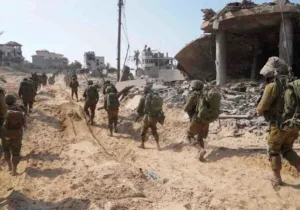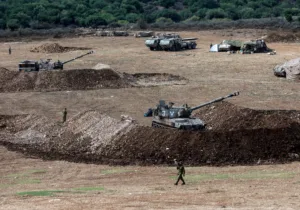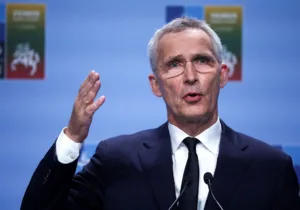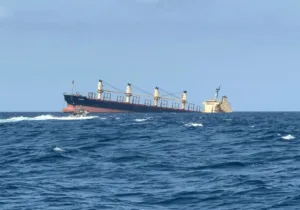As we continue to sift through the shrapnel of President Donald Trump’s decision to pull US troops out of Syria and green-light Turkey’s long-planned operations against Syria’s Kurds and Syrian Democratic Forces (SDF) in northern Syria, we need to keep in mind that what transpired in October represents only the short-term consequences. As with President Barack Obama’s unenforced “red line” warning to Syrian dictator Bashar al-Assad, the long-term consequences of President Trump’s green light to Turkish strongman Recep Tayyip Erdoğan are still taking shape, like a storm gathering in the distance.
Ashamed
Before getting into those likely long-term consequences, here are some consequences we already know.
Erdogan added to the humanitarian catastrophe that Syria has become during eight years of civil war, terrorist attacks, counterterror operations, chemical warfare, and ethnic cleansing.
Thanks to him, 300,000 civilians have been displaced. Human rights observers report that Kurdish politicians and uniformed Kurdish soldiers have been executed; Kurdish civilians and journalists have been killed by Turkish airstrikes; medical centers have been targeted. Amnesty International accuses Turkey and its partners of “launching unlawful deadly attacks in residential areas that have killed and injured civilians.” In addition, Amnesty reports that Erdogan is forcibly moving Syrian refugees sheltering in Turkey to the so-called “safe zone” in northern Syria, even though that “safe zone” is more akin to a warzone.
Jim Jeffrey, US special representative for Syria, concludes, “We’ve seen several incidents which we consider war crimes.”
Green-lighting Turkey’s assault on Syria’s Kurds has also stained American honor. The SDF fought alongside American special-operations units for more than five years. During that time, American troops trained 60,000 SDF personnel. Unlike so many of our allies, who always seem willing to fight to the last American, the SDF fought tenaciously against our common enemy and sacrificed 11,000 men in the brutal, block-by-block, village-by-village campaign to liberate northeastern Syria from ISIS.
It’s no wonder that Green Berets say they feel “ashamed” of this betrayal. One Army officer told the New York Times, “They trusted us, and we broke that trust.”
Yet another consequence of leaving the SDF and Syria’s Kurds to the tender mercies of Erdogan’s army: It rewards Ankara’s growing record of bad behavior, which will lead to worse behavior. Recall that Erdogan has smashed Turkey’s democracy, steered his country toward authoritarianism, cozied up to fellow strongman Vladimir Putin, purchased Russian weapons over NATO and US objections, blocked NATO allies from visiting NATO forces deployed in Turkey, and prevented US and NATO assets from flying out of Incirlik. Yet President Trump’s response to this record of recalcitrance is to reward Erdogan with a sliver of Syria.
As unintended consequences go, that’s a rather awful list. But it’s going to get worse—no matter how many times the president reassures us that “we’re 7,000 miles away.”
Vacuum
That brings us to the long-term consequences.
First, the Syria pullout will lead to a diminution of anti-terror efforts.
“We obviously had troops there, the mission was defeating ISIS, so if you remove those troops before that mission is complete, you have a problem—and we do have a problem right now,” Jeffrey says.
Foreign Affairs reports a “flurry of prison breaks” in northern Syria, where thousands of ISIS fighters were being held by our (former) SDF partners.
Gen. John Kelly adds, “What was working in Syria was that for very little investment, the Kurds were doing all the fighting, the vast majority of the dying, and we were providing intelligence and fire support assistance. And we were winning.”
Indeed, US commandoes in Syria and their SDF partners were conducting a dozen counterterror missions per day. Those missions—essential to keeping the enemy focused on survival rather than focused on planning attacks in the West or building a caliphate in the Middle East—have slowed in tempo and been made more difficult due to the tyranny of distance. Thus, the Pentagon is coming to grips with “the rebirth of an Islamic State sanctuary,” Politico reports.
Doubtless, President Trump’s counterpoint is that ISIS leader Abu Bakr al-Baghdadi died during a US operation inside Syria. This is a welcome tactical victory in the war on jihadist terror. But as with al-Qaeda after Osama bin Laden’s takedown, ISIS will continue to sow death and destruction after Baghdadi. That’s because we are fighting an ideology—not an individual.
The irony of the Baghdadi strike is that the operation’s success was a function of SDF efforts as well as the presence of US troops in Syria. No matter. One gets the sense President Trump will view the elimination of Baghdadi in the same way President Obama viewed the elimination of bin Laden—as a validation of his approach and a springboard into an accelerated pullback.
That’s the second long-term consequence of the Syria pullout. President Trump’s green light in Turkey and President Obama’s red line in Syria serve as metaphors for America’s retreat from the leading role it played on the world stage between 1941 and 2009.
President
Obama drew his red line in late 2012. When Assad crossed it by using chemical
weapons in 2013, it was imperative for the president to enforce that red line,
not only to buttress the taboo against weapons of mass destruction and thus
deter their further use, but to make it clear that America’s word matters—and
America’s threats are not empty. Instead of enforcing his red line, President
Obama blinked. The cascading consequences included continued use of WMDs, a
heightened sense of insecurity among regional allies, and the return of Russia
to a region from which it had been exiled since the end of the Cold War. Putin
smilingly promised to cajole Assad into handing over his WMDs. But as chemical
weapons continued to be used and President Obama continued to leave his red
line unenforced, Putin reckoned it was safe to intervene militarily to prop up
Assad’s tottering regime. Assad was rescued, and Moscow was again a player in
the Middle East.
President Obama issued his red line threat just eight months after he withdrew US
forces from Iraq—disregarding the recommendations of Gen. Lloyd Austin (commander of
US forces in Iraq), Joint Chiefs Chairman Adm. Mike Mullen, Gen. Martin Dempsey
(Mullen’s successor), and
Defense Secretary Leon Panetta, who lamented that the
Obama White House was “so eager to rid itself of Iraq that it was willing to
withdraw rather than lock in arrangements that would preserve our influence and
interests.”
In Iraq, as in Syria, the worst of the worst consequences didn’t manifest themselves immediately. But soon enough, al-Qaeda in Iraq reconstituted and rebranded itself as ISIS; Baghdad was nearly overrun; Yazidis, Shiites, and Christians were massacred; and ISIS declared a jihadist state in the heart of the Middle East. So President Obama rushed US forces back into Iraq. That wouldn’t have been necessary if he had simply heeded the counsel of his advisors and maintained a modest-sized stabilization force in Iraq. But President Obama didn’t listen to such counsel regarding Iraq, and President Trump isn’t listening regarding Syria.
Since geopolitics, like nature, abhors a vacuum, others inevitably filled the space America’s withdrawal left, which brings us to a third long-term consequence of President Trump’s Syria pullout.
Expanding the foothold he gained after President Obama’s red line for Assad, Putin immediately rushed in after President Trump’s green light for Erdogan, hammered out a deal to establish a buffer zone in northern Syria, and offered succor to the friendless Kurds. “Abandoned by US forces and staring down the barrel of a Turkish invasion, Kurdish fighters had no option but to turn to Assad’s government and to Russia for protection from their No. 1 enemy,” AP reports.
As Kelly explains, Washington’s decisions have “opened the way for the Russians to be very, very influential in the Middle East.” Thanks to its new perch in Syria, Moscow is limiting the US military’s freedom of maneuver in the region (especially in and above the eastern Mediterranean), bolstering Iran and Syria, and complicating Western diplomatic efforts in an already complicated region.
The dichotomy is not lost on regional leaders. While Washington draws red lines that go unenforced and green-lights operations that send its partners reeling, Moscow steadily backs and bolsters its friends.
Nor is the fallout limited to the Middle East. Given that President Trump has defended his green light by noting the Kurds “didn’t help us with Normandy” and pointing out Syria is “7,000 miles away,” what message does this send to the South Koreans (5,820 miles away, didn’t help us at Normandy), Lithuanians (4,450 miles away, didn’t help us at Normandy) and Taiwanese (6,698 miles away, didn’t help us at Normandy)?
Nor is the fallout quarantined overseas. Military officials are bracing for what President Trump’s next tweet might set in motion. “The Pentagon recently began drawing up plans for an abrupt withdrawal of all US troops from Afghanistan in case President Donald Trump surprises military leaders by ordering an immediate drawdown as he did in Syria,” NBC reports.
Chaos
Add it all up, and there is less order and more chaos as a direct result of Washington’s policies.
A 2017 Washington Post analysis concluded, “Every indication from what we know of Trump the businessman and reality TV star suggests that he revels in the chaos, that he believes the chaos produces just the sort of results he likes.” This may be true in the boardroom and on TV, but it does not hold when it comes to foreign policy, as we have seen in Syria (and as I predicted upon his inauguration).
Chaos does not serve US interests. Responsible powers like the United States are expected to be, well, responsible, which means the US should promote stability and order. We sometimes forget that God is deeply interested in order. Genesis tells us God brought order out of chaos. Jeremiah says God “made the earth…and gave it order.” Paul urges us to pray for “all those in authority that we may live peaceful and quiet lives.” The implication: Legitimate governments exist to promote order in a broken world bent toward chaos.
The United States in recent years has not lived up to that standard, and the consequences are everywhere on display.







 Sponsor a student for Christianity & National Security 2024
Sponsor a student for Christianity & National Security 2024